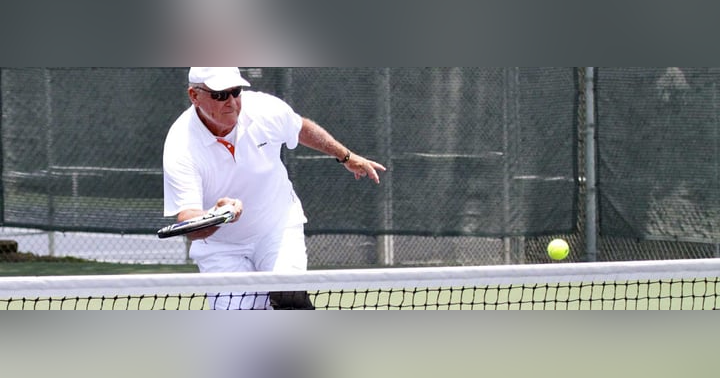Glossary of tennis terms and acronyms

Like many sports, tennis is a game full of terms and acronyms. This article seeks to help explain the meaning of these items. It will remain 'work in progress' and we will be adding as we discover new terms or acronyms. If you consider we can explain one of them better, or have missed anything, then feel free to comment below or email us at hello@tennisletics.com.
Ace - When a serve is untouched and unreturned by the receiving player, meaning the player who served wins the point.
Advantage (shortened to ‘Ad’) - The player who wins the first point when in deuce has the ‘advantage’. From here that player only needs one more point to win the game.
Alley - The extra space at the side of the court that is used when playing doubles.
ATP - Abbreviation for the Association of Tennis Professionals, the governing body that oversees men’s tennis.
Backhand - A shot that is played by swinging your racket across your body to strike the ball with the back of the racquet head.
Backspin - A shot that causes the ball to rotate backward causing the ball to slow down and/or bounce at a lower angle. Also known as a slice.
Baseline - The line at either end of the court that indicates the back of the court.
Break - When the player who is serving loses a game.
Breakpoint - The point before a player breaks serve.
Chair Umpire - The senior official who enforces the rules of the game. The chair umpire is positioned in line with the net and sits in a high chair. Challenge - A player can request an instant replay review of where a ball has landed to ‘challenge’ the umpire's decision. In matches where Hawk-Eye technology is available players are allocated a set number of ‘challenges’.
Changeover - A break that occurs after every odd-numbered game where players change sides of the court. The ‘changeover’ period is 90 seconds.
Deuce - When a game is scored 40-40. When Deuce is reached a player must win 2 points in a row in order to win the match.
Deuce-Court - The right-hand side of the court. It is known as deuce-court because all deuce points are played from this side.
Double Fault - When the server misses two serves in a row causing them to lose the point.
Down the line - A shot that is hit straight along the sideline of the court.
Drop shot - A very light shot that is intended to just go over the net and drop short in the oppositions half.
Error - A shot that lands outside of the court meaning the point is lost.
Fault - A Serve that doesn’t land within the oppositions service box.
First Service (or Serve) - The first of two serves that a player is allowed. Players will typically attempt more risky shots on the first service as they still have a second attempt if they fault the first serve.
Foot Fault - When the server touches or moves over the baseline during his service motion, a foot fault is treated the same as a normal fault.
Forced Error - When a player misses a shot as a direct result of pressure from their opponent. See Unforced Error.
Forehand - A shot in which the ball is hit with the front of the racket.
Game - A sequences of points with the same players serving. A game is scored 0-15-30-40-Game.
Game point - When a player is one point away from winning a game.
(A) Grand Slam - The four most prestigious tennis tournaments that take place each year; the Australian Open, the French Open (or Roland Garros), Wimbledon and the U.S. Open.
(The) Grand Slam - Not to be confused with A Grand Slam. The Grand Slam is when the same player wins all four Grand Slam events, if they were to win them all in the same year it would be referred to as a ‘Calendar Grand Slam’.
Half Court - The line halfway between the net and the baseline.
Hawk-Eye - Technology that is able to track the flight of the ball. Hawk-eye is used when players want to challenge the umpire's decision.
ITF - The abbreviation for the International Tennis Federation, world tennis’ governing body.
Let - A serve where the ball hits the top of the net and lands within the receivers service box. If the ball lands within the service box a second serve is given, if it lands outside the area of play it is counted as a serve attempt.
Line Umpire - The official who makes calls on whether the ball lands in play or not, the line umpire can be overruled by the chair umpire.
Lob - A shot that is played high above the net towards the back of the court in the attempt to play the ball over the opponent when they are close to the net.
Love - The term to indicate a score of zero.
Match - The official term for a contest between two players, or two sets of doubles. Matches are either played as a best of three sets or a best of five sets.
Match point - When a player is one point away from winning the match.
Overhead Shot - Any shot that is hit above the head of a player. Poaching - A tactic in doubles where the player at the net attempts to volley a shot that their partner on the baseline would usually return.
Racquet (or Racket) - A sports implement consisting of a handled frame with an open hoop across which a network of tightly stretched strings used for striking a ball.
Rally - A back and forth exchange where both players are hitting the ball to each other.
Return - When a player hits the ball back to their opponent, usually used in the context of a ‘return of serve’.
Return+1 - A term used for the first two shots by the returner - the return itself and their next shot.
Return Ace - When a player returns a serve and that shot cannot be returned.
Second Service - If a players serve does not land within the court they can have a second, and final, attempt to serve.
Serve+1 - A term used for the first two shots by the server - the Serve itself and their next shot.
Service Box - The box on the court where the serve must land.
Service line - The line running parallel to the net that indicates the boundary of the service box.
Set - A set is made up of a number of matches. A player needs to win at least six matches to win a set and in order to win the set, they must have a lead of at least two games. When a game is scored 6-6 the set will go to a tiebreak. If the game is scored 6-5 the player who has won 6 matches must win one more game to win the set 7-5.
Set Point - When a player only requires one more point to win the set.
Slice - A shot that is hit with backspin.
Straight Sets - When a player wins a match without losing a set.
Tiebreak - When the score in a set reaches 6-6 the players must play a tiebreak. The first player to win 7 points wins the tiebreak, however, they must win by at least 2 clear points meaning the score can go much higher than 7. A ‘Super Tiebreak’ is played to 10 points and often used instead of a third set
Touch - If a player makes contact with the net with their body of racket it is known as ‘touch’ and the player loses a point.
Topspin - A shot that caused the ball to spin forwards meaning the ball bounces higher and dip down quickly.
Unforced Error - When a player misses a shot with that has no pressure from their opponent. See Forced Error.
Winner - An outstanding shot that the opposing player cannot return.
WTA - An abbreviation for the Women’s Tennis Association, the organization that oversees women’s tennis.











